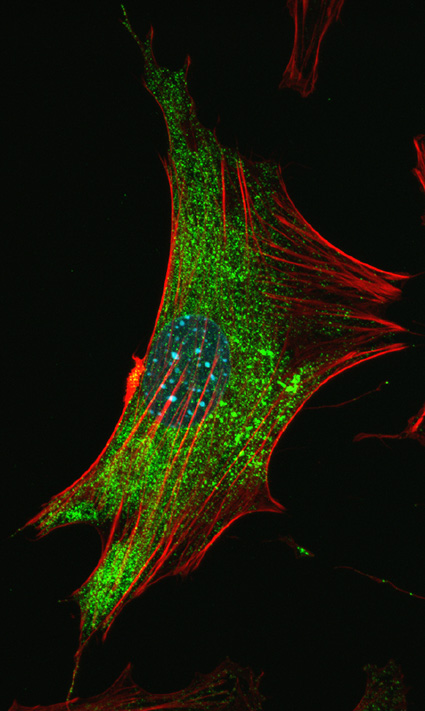Research on fragile X syndrome, the most common inherited cause of mental retardation, has focused mostly on how the genetic defect alters the functioning of neurons in the brain. A new study focusing on a different type of brain cell, the glial cells known as astrocytes, indicates they also are impaired by the genetic defect and are involved in the symptoms of the disease.
Scientists are eager for new insights into fragile X syndrome since the failure in 2014 of two large clinical trials of drugs designed to treat the disease. Both drugs are inhibitors of a neurotransmitter pathway thought to be overactive in the brains of people with fragile X syndrome. The new findings, reported in a paper accepted for publication in Biological Psychiatry, may not explain the failure of those drugs to alleviate symptoms of the disease, but they do suggest that researchers need to look beyond neuronal effects to fully understand it.
"The clinical trials were a big disappointment because the drugs had been effective in animal models of fragile X syndrome. But if you compare humans to mice, we have a much higher ratio of astrocytes to neurons in our brains, so the effects on astrocytes may be more important in humans," said Yi Zuo, professor of molecular, cell, and developmental biology at UC Santa Cruz and senior author of the new study.
Glial cells were originally thought of as simply the "glue" that holds the neurons together in the brain, but they are now known to have a wide variety of important functions. Astrocytes, the most numerous glial cells, greatly outnumber neurons in the human brain and play crucial roles in neuronal functions and in the formation and stability of synapses (the connections between neurons).
Synapse formation
Synapse formation is significantly affected by fragile X syndrome, with both human and animal studies showing abnormal development of "dendritic spines," the neuronal structures that form synapses. The syndrome is caused by a genetic defect on the X chromosome that knocks out production of a protein called fragile X mental retardation protein (FMRP), a negative regulator of protein synthesis that affects the expression of many different proteins.
Zuo, whose research focuses on synapse formation during learning, looked at the influence of FMRP on this process using a mouse model of fragile X syndrome. FMRP is normally expressed in both neurons and astrocytes. Zuo's lab developed mice in which FMRP was either selectively deleted or exclusively expressed in astrocytes, then tracked the development of dendritic spines on neurons in the brains of these mice and tested their ability to learn new skills.
The results showed that eliminating FMRP only in astrocytes led to abnormal development of dendritic spines as well as impaired learning of motor skills. But if FMRP was expressed only in astrocytes and not in neurons, spine development and learning ability were still abnormal.
"You need FMRP in both neurons and astrocytes for normal development of synapses," Zuo explained.
The study also showed that loss of the FMRP protein causes an increase in spine formation during adolescence and less "pruning" of synapses during later development. As a result, adult mice lacking FMRP have an overabundance of dendritic spines, which is also seen in humans with fragile X syndrome.
"In future studies, we want to look at the molecular mechanisms involved in these observations," Zuo said. "We are just beginning to recognize the importance of glial cells in neural development and neurological diseases. Astrocytes are very difficult to manipulate and study, so there is still a lot we do not understand."
The lead authors of the paper are Jennifer Hodges, a postdoctoral researcher in Zuo's lab at UC Santa Cruz, and Xinzhu Yu, a former graduate student in Zuo's lab now at UCLA. Other coauthors include Anthony Gilmore, Hannah Bennett, Michelle Tjia, James Perna, Chia-Chien Chen, and Ju Lu at UC Santa Cruz, and Xiang Li at the Shenzhen Institutes of Advanced Technology in Shenzhen, China. This work was supported by grants from the National Institute of Mental Health and the National Institute of Neurological Disorders and Stroke.



